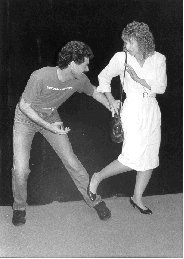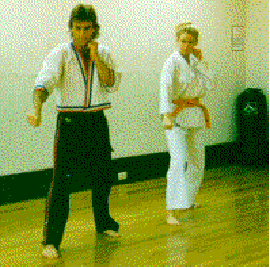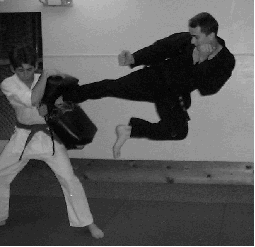“Take a breath: some ideas on breathing”
Learning to breathe correctly is an important part of Martial Arts practice. The breathing method that is taught in Mudokai Karate is based upon principles passed down by my instructors and upon my own research and experience. Correct breathing in class is essential to gaining the full benefit every session. We use the breath in Karate to focus our mind, balance our feelings, time our technique, reinforce our center, focus our intent and empower our strikes. Under certain circumstances we use it to control our mind so that we can be temporarily invulnerable to pain, and able to achieve complete coordination of our bodies with our consciousness.
|
Through proper breathing you will have the poise necessary to defend yourself if required. Sensei Pattie Embick demonstrates defense against a purse snatch
|
 |
When we begin to stretch at the start of each class we must focus on breathing away from the pain that we feel as the muscles stretch. This pain should be in the muscles and the tendons, and is perhaps better described as a “stretching feeling”, as the word pain has some negative connotations. The idea is to stretch further than is normally comfortable. If any pain is felt in the joints, like the hip, knee or shoulder for example, we should stop and change our position so as to isolate the stretch correctly. We don’t want to injure ourselves trying to get fit. Provided that we are feeling the stretch in the correct place, it is essential to correctly extend into the stretch so that our flexibility will increase. By using the breath as a point of focus we can stretch a little further every time that we exhale, and relax into the stretch a little more every time that we inhale. If all of our mind is on the breath there will be no mind left for the pain. During the warm-ups the breathing should be long, smooth and steady. We emphasize abdominal breathing so the abdomen must fill with air as we inhale. Chest breathing is always to be avoided.
Once we begin to train on our punches, blocks and kicks we must exhale strongly and quickly with each of these techniques. By breathing out very hard as we strike we stimulate the parasympathetic nervous system which will tend to lower the heart rate and decrease our blood pressure. This allows us to feel relaxed and poised even while working out with a high level of intensity. We also use our exhalation to add focus to every strike by exhaling right at the moment of impact or full extension of each strike. Ideally we will experience a moment of complete simultaneity with every strike. This will involve the strike landing at the same time as our foot lands or our hip twists, and at the same time as we tense our stomach. This simultaneous, coordinated effort allows us to achieve the highest level of focus, permitting all of our available power to be brought to bear on our target at the moment we strike.
In order to learn to breathe from the abdomen, rather than merely from the chest, students can practice breathing at home. It can be a kind of meditation. Begin by sitting comfortably on a cushion or a chair with a nice straight back. Place one hand upon the stomach. Imagine that you are being held up by a string attached to the back of your head. As you breathe in through your nose you should feel your stomach fill with air. As you breathe completely out you should feel the stomach deflate. Wherever possible all breathing should be through the nose. This will prevent the loss of water vapor which occurs when you exhale through the mouth. A loss of water vapor upsets the salt balance in the body and leads to early fatigue. Inhaling through the mouth tends to dry up the throat. It also makes the jaw vulnerable to a strike if you are sparring or defending yourself. Keep the lips lightly touching and the breath smooth and connected. To be sure that your breath is smooth listen to the sound it makes as it goes in and out. If you hum quietly on the exhalation the note should stay the same. If you were able to hum on the inhalation that note would also be the same. To be sure that your breath is connected make sure that at the top of the inhalation there is no holding of the breath. Similarly the breath must not be held at the bottom of the exhalation. Allow the transition from inhalation to exhalation to be smooth and connected.
If you want to improve your basic breathing place a timepiece in front of you where you can easily see the second hand. Exhale for five seconds and smoothly transition into the inhale for five seconds. If you are comfortable you can work up to ten seconds in and ten seconds out. If you feel dizzy or suffer other discomfort relax and breath normally for a while. It means that you are overdoing the exercise and trying too hard. Keep your practice smooth, full, even and connected. It’s not a competition. Eventually you may be able to work up to taking thirty seconds on the inhalation and thirty seconds on the exhalation for thirty minutes. That is just thirty complete breaths in half an hour.
If you are working on Seishan Kata the breathing emphasizes a very slow strong exhalation, accompanied by tensing the stomach muscles strongly as you extend the tail bone downward. This is followed by a very quick inhalation as you suck as much air as possible into the abdomen in about one second. You can practice the breathing sitting down as you visualize the Kata. Again, be sure to pay attention to any warning signals like dizziness, headache or other signs of discomfort that would indicate that you are practicing incorrectly.
Breathing accompanied by positive visualization can be very productive as a practice format for Martial Arts, or any other skill development. Over time you must establish abdominal breathing as your default breathing style, and train your reflexes to respond to any stressor, surprise or shock with a strong and immediate exhalation. In a crisis this will bring you to an immediate state of focused concentrated readiness. You will be centered in your belly, your body will be poised but relaxed and emotionally balanced. You will be in the optimum condition to deal with whatever is happening, having used your breath to bring you to a state of “oneness”: a condition where you are physically, emotionally and mentally focused in the present right here and now. This inherently spiritual condition is a collected state that will allow you to optimize all of your potential to handle whatever challenges life happens to bring your way.
Sensei Robert H. Mason c 2001
Benefit from a fitness routine and relieve stress
A doctor working in the field of stress appeared on a recent episode of Oprah. She measured the effects of stress on a working mother of two throughout one day in her busy life. The results of the day’s monitoring showed that the mother’s heart rate was over 100 on average and her blood pressure was abnormally high as well.
The stress doctor concluded that “unrelieved stress”, such as that endured by a typical mother, adds years to our age and takes a huge toll on our physical, emotional and mental health. Symptoms such as restless sleep, recurring illness, brittle nails, road rage and hair loss can all be signs of an overstressed lifestyle. In addition to taking frequent breaks during the day, meditating and proper scheduling and prioritizing of physical activity/exercise is considered by many to be the single biggest factor in creating health, especially as we age.
 |
The repetitious
movements of Kata practice can be used as an active meditation to
inspire a quiet state of mind
Sensei Chris Kent practices with Alona Shaw |
Our hectic lifestyle with its long work hours, short vacations, fast food diet and high speed/high tech/fast change format leaves little “down time” for adults. Europeans, with their more leisurely approach to living: mid-day breaks of two hours for lunch while shops and business close and six-week vacations even in the first year of a job, often say that they work to live while Americans, with their frantic meal breaks and minimal time off for vacations, live to work.
 |
Striking focus pads or a kicking shield can release stress accumulated during a day at work Sensei Bergstresser practices against a kicking shield |
Europeans also tend to bicycle and to walk more as their countries are often smaller than the U.S. and their lifestyle less comfortable in terms of automobile ownership. Their food is often less fabricated and more nourishing. Fast food is an American invention which is one of the reasons why diabetes and other degenerative diseases are epidemic in this country. By the way, karate is an excellent sport for diabetics as it improves circulation in the feet.
Give yourself a recreation break and consider including regular exercise in your daily regimen. Talk with a friend and join a class together. Speak to a co-worker and schedule in a fitness routine. Over the years we have trained many adults from all walks of life, from teenagers to senior citizens. Martial arts can help you gain physical, emotional and mental fitness while you learn a skill and have fun doing it.
Sensei Robert H. Mason c 2001
Martial Arts for Survival and for Life
So 2001 is here and we are now truly entering a new millennium. I took in a movie on January first called “Cast Away”. For me the film illustrated, through the lead character, how useful it is to be able to persevere. Perseverance is an important attribute for Martial Artists because it allows us to work through the difficulties presented in the course of training. If our training was all a “no sweat” experience we would not achieve the gains that it brings us. While those gains may not be noticeable week to week, if you look back over the last year and see how far you have come since last January, you will have a useful perspective on the growth process involved.
Of course, as in all things, there is a relationship between “work in” and “work out” in this respect. To make the most of your work-outs this year, make an inner commitment to include all three essential ingredients in your training mix:
Frequency - train often.
Intensity - train hard.
Allow time - for your training to bear fruit. Success in the Martial Arts is not an overnight phenomenon.
Because of the opportunities we have today, we are not concerned merely with survival, but also with the quality of our experience in life. Similarly, in our Martial Arts training, while Self-Defense is always an important consideration, there are many additional reasons why we train, and ways in which we benefit from training regularly. For those students who want to accelerate their progress I recommend that they join the tournament team. Competition is a great motivator, and additionally serves to increase our ability to deal with emotions and internal pressures that are inspired by facing an opponent in the ring. The true opponent is of course ourselves, but it’s the other guy who is trying to kick you in the head. Dealing with nerves, adrenaline and even terror in a controlled environment creates a unique personal growth opportunity, and over time develops a winning attitude that transcends the reward of a trophy or a medal, though there is nothing wrong with winning a trophy.
Generosity is part of the theme of the December Holiday Season, and in a continuation of that spirit I would like all of my students to consider offering the benefits of Martial Arts training to any friends, acquaintances or family members who have not trained here up to now. We invite all of our regular members to offer their friends a “VIP package” that entitles them to two weeks of unlimited training, registration and a complete Martial Arts Uniform Free of Charge. Karate is not just for survival, it is a way of life we can share together.
Sensei Robert H. Mason c2001
Ten Tips to Kata Performance
Christine Bannon-Rodriques reveals some of the kata secrets you need to excel in competition.
There are many factors that officials look for when judging forms. Following are 10 tips that should help you excel, in competition, demonstration or grading.
1. Basics
Regardless of your rank, your basics need to be sharp. As a beginner, your basics might consist of a front kick and some simple punches. As an advanced competitor, your basics might include spinning kicks, jumping kicks or multiple hand techniques and combinations.
2.
StancesStances are like the foundation of a house. If they're weak, you'll have weak foundation or a poorly built house. If they're strong, you'll have a strong foundation or a strong, sturdy home. Keep your stances as low as they should be. Be sure that your weight distribution and foot alignment are accurate. Your posture is also very important before and after your presentation.
3. Power
A form is a self-defense scenario against imaginary opponents. Therefore, your movements better be effective. Strong kicks, punches and blocks are essential. It's better to have a strong low kick rather than a weak high kick. Always focus on powerful rather than flashy techniques.
4. Balance
Stumbling during a forms routine is a major error. It's not impossible to lose your balance, especially if you're throwing advanced techniques. Therefore, demonstrate good balance and show that you are in control during the entire routine.
5. Speed
Some basic, traditional forms do not require much speed from strike to strike. However, even in a simple form, show great speed in a single kick or a single punch. In the more advanced forms, showing a quick combination of movements is important. Try not to make your entire routine a blur, though. Stop for a couple of seconds after each combo to let the judges appreciate your solid stances, incredible balance and perfect basics. Allow definition and form to guide you rather than emphasizing only speed.
6. Intensity and Presence
Remember, when you are performing a form, you are fighting imaginary opponents. Therefore, you should not have a blank look on your face or a smile. Be intense. Use your facial expressions to let the judges visualize what you are really doing. Be vocal and use your internal Ki (energy) to deliver more power through your kiai (spirit yell).
7. Focus and Concentration
You must focus if you want your techniques to be accurate. Usually, when a person's eyes start to wander, he is unsure of his next move. Keep your concentration, regardless of whether someone starts playing loud music in the ring next to you or you didn't practice enough.
8. Flexibility
If your flexibility is good, you will be able to perform harder, fancier kicks or gymnastic moves. I don't think there is anything more exciting than watching someone throw a kick straight up with good execution and power. If you're a traditionalist, good flexibility will allow you to move with greater ease.
9. Difficulty of Movements
The more difficult your moves are, the higher you'll score. However, many people put difficult moves in their routines before they are ready to throw them flawlessly. Wait until you can nail them every time.
10. Have a Good Backup
Make sure you know the rules regarding ties. Some tournaments may require a different routine. Even if they don't require a different form, have a solid backup. If you can go out and do a different form just as well as the first, you are showing how multi-dimensional you are.
 |
About the author: Christine Bannon - Rodrigues, a member of Team Paul Mitchell, won 135 grand championships during her career. |
Bruce Lee’s Eight Points of Strategy
1 Speed
: Bruce Lee realized that a heavy muscular build can slow you down. He trained for speed. His speed was definitely beyond average. Use every opportunity to increase your reflexive speed.2 Timing: Bruce had timing. He would often observe his opponent and counter attack at precisely the right moment. Speed allows you to maximize the opportunities that good timing make available.
3 Power: Push-ups, sit ups and resistance training allowed Bruce to do more damage with a two-inch punch, than many can do with regular punches. Bruce Lee developed the power to bring down much larger opponents.
4 Feinting and Faking: Bruce Lee believed that if two opponents were equal in skill, speed and power, the competitor who could use feinting techniques the best would be the victor. Bruce Lee advocated the use of feinting and faking in fighting and illustrated these moves in his movies.
5 Movement: A body in motion tends to stay in motion. Bruce Lee moved efficiently to avoid inertia which can leave a fighter stuck and vulnerable.
6 Footwork: Bruce Lee moved like a butterfly and stung like a bee. He believed that the best way to avoid a punch or kick was to dodge or move out of the way.
7 Focus: Bruce had the desire to be the best. He trained every day for several hours. He pushed his body to its limits and worked on maintaining mental focus.
8 Knowledge: Bruce read widely about diverse subjects. He worked to gain knowledge in order to make himself a better individual and martial artist.